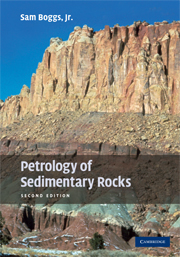Book contents
- Frontmatter
- Contents
- Preface
- Part I Principles
- Part II Siliciclastic sedimentary rocks
- Part III Carbonate sedimentary rocks
- Part IV Other chemical/biochemical sedimentary rocks and carbonaceous sedimentary rocks
- Chapter 12 Evaporites, cherts, iron-rich sedimentary rocks, and phosphorites
- Chapter 13 Carbonaceous sedimentary rocks
- References
- Index
- References
Chapter 13 - Carbonaceous sedimentary rocks
from Part IV - Other chemical/biochemical sedimentary rocks and carbonaceous sedimentary rocks
Published online by Cambridge University Press: 05 June 2012
- Frontmatter
- Contents
- Preface
- Part I Principles
- Part II Siliciclastic sedimentary rocks
- Part III Carbonate sedimentary rocks
- Part IV Other chemical/biochemical sedimentary rocks and carbonaceous sedimentary rocks
- Chapter 12 Evaporites, cherts, iron-rich sedimentary rocks, and phosphorites
- Chapter 13 Carbonaceous sedimentary rocks
- References
- Index
- References
Summary
Introduction
Most sedimentary rocks, including rocks of Precambrian age, contain at least a small amount of organic matter consisting of the preserved residue of plant or animal tissue. The average content of organic matter in sedimentary rocks is about 2.1 weight percent in mudrocks, 0.29 percent in limestones, and 0.05 percent in sandstones (Degens, 1965). The average in all sedimentary rocks is about 1.5 percent. Organic matter contains about 50–60 percent carbon; therefore, the average sedimentary rock contains about l percent organic carbon. A few special types of sedimentary rocks have significantly more organic material than these average rocks. Black shales and other organic-rich and bituminous mudrocks typically contain 3 to 10 or more percent by weight of organic matter. Some oil shales contain even higher percentages, ranging to 25 percent or more, and coals may be composed of more than 70 percent organic matter. Certain solid hydrocarbon accumulations, such as asphalt and bitumen deposits formed from petroleum by oxidation and loss of volatiles, constitute another example of a sedimentary deposit greatly enriched in organic carbon. In fact, even liquid petroleum can be thought of as a special kind of organic-rich deposit although it is clearly not rock. Sedimentary rocks containing significant enrichment in organic matter over average sediments are called carbonaceous sedimentary rocks. The amount of organic matter required to designate a sediment as carbonaceous is not firmly established.
- Type
- Chapter
- Information
- Petrology of Sedimentary Rocks , pp. 527 - 555Publisher: Cambridge University PressPrint publication year: 2009
References
- 2
- Cited by



